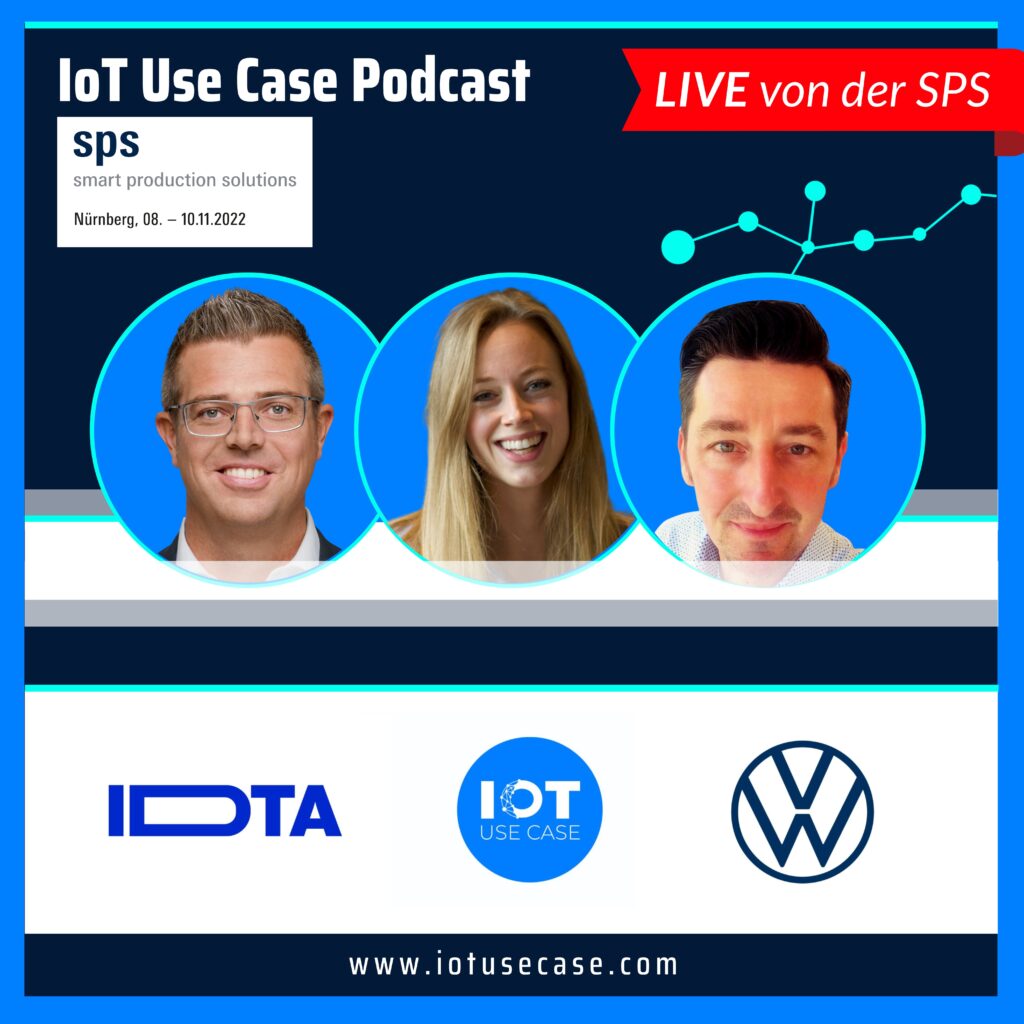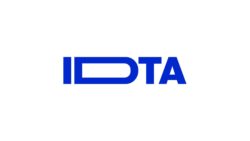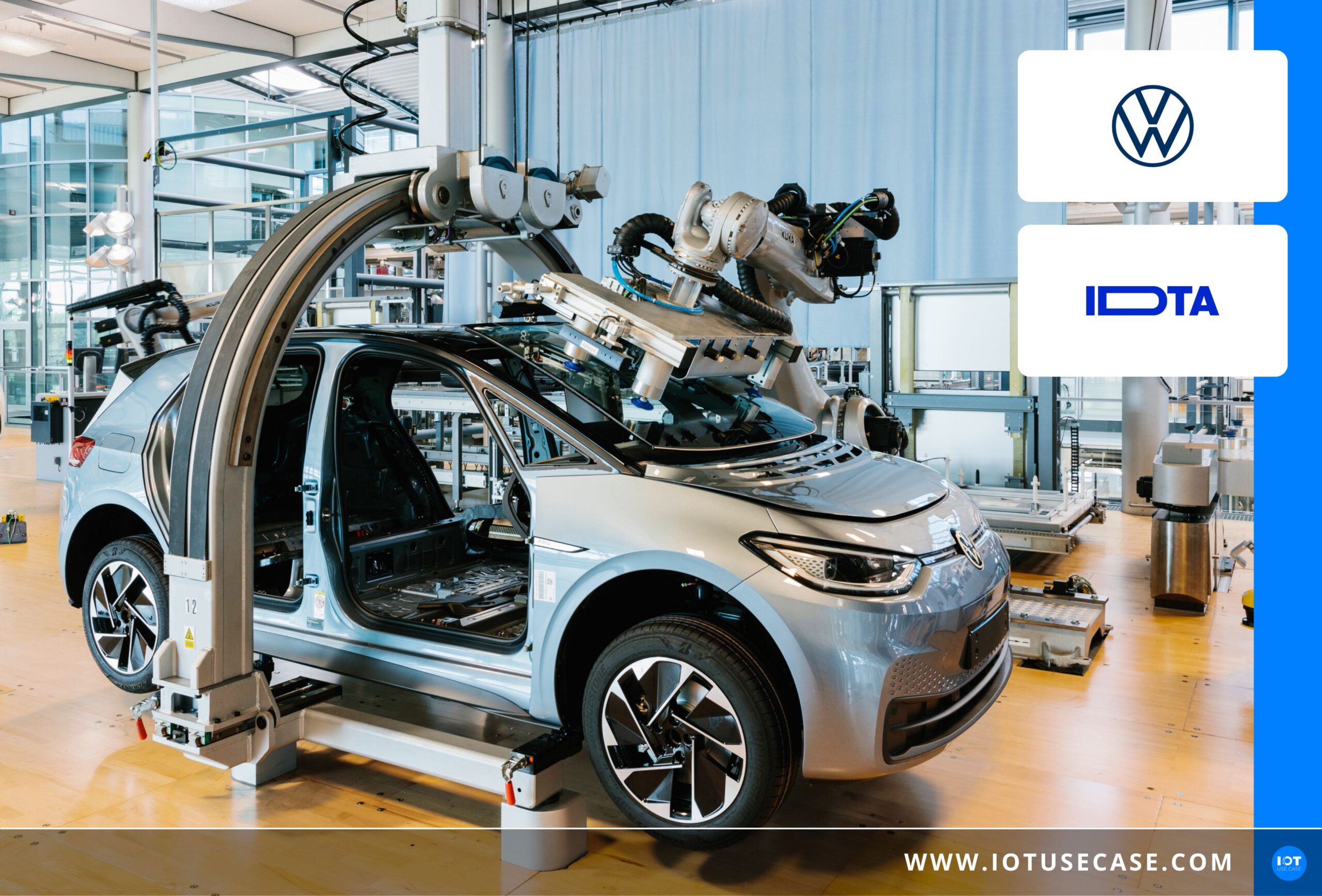Volkswagen Sachsen GmbH is driving forward important milestones in electromobility and digitization. A major milestone is the establishment of a digital plant twin to identify the largest (energy) losses in manufacturing processes. They are not alone on this challenge: As one of the more than 80 members of the Industrial Digital Twin Association e. V. (IDTA), they are standardizing the digital twin of production.
Episode 80 at a glance (and click):
[07:38] Challenges, potentials and status quo – This is what the use case looks like in practice
[13:40] Solutions, offerings and services – A look at the technologies used
[21:47] Results, Business Models and Best Practices – How Success is Measured
Podcast episode summary
This special episode LIVE from the SPS in Nuremberg revolves around the Digital Twin as a key technology of Industry 4.0. The Digital Twin connects physical industrial products with the digital world. For the successful practical implementation and international dissemination of this core technology, a common understanding among all stakeholders in industry, associations and research is necessary. This is the task that the IDTA has taken on.
Production landscapes – including those at Volkswagen Sachsen GmbH – are characterized by new and existing plants with varying degrees of networking. In order to carry out an energy demand-based optimization for the entire plant, data from many plants and, up to now, the implementation of several use cases have been necessary. In order to save engineering efforts, a data foundation with the same information models for all devices is needed – energy efficiency through standards! With the so-called Asset Administration Shell, IDTA as a user organization now opens this technology for every company.
The administration shell enables the digitization of energy demand-oriented production in the Green- and Brownfield. It is the information basis for digital twins and can reduce costs on the shopfloor in terms of planning, commissioning and operation as part of energy demand measurement.
But what exactly is this so-called administration shell, how does it work and what other added value does it provide? Dr. Christian Mosch (Managing Director, IDTA) and Dr. Dirk Thieme (Head of New Mobility and Innovations, Volkswagen Sachsen GmbH) explain this in episode 80 of the IoT Use Case Podcast.
Podcast interview
Keyword IoT: everyone is talking about it – but what does it mean in concrete terms? In the network, we want to answer the question and bring transparency to the market. On the one hand, talk about use cases that already add monetary value. Best practices to share. And on the other hand to bring back a bit of confidence in the market and to highlight partners who have great references!
From Volkswagen Sachsen GmbH, Dirk is with me, together with Christian from IDTA, our partner around the topic of standardization. It’s about digital twins in the plant, and about creating uniform data models to drive networking and implement concrete use cases that save costs in the plant. And Christian, you deal with the topic of software specification as an association with the goal of standardizing the digital twin. What is your founding story?
Christian
The topic of digital twins is a longer story. If you look at the founding date, that fits well with the location here: 2019 saw the first demonstrators of a core digital twin standard. Asset Administration Shell.
In this respect, 2020 was characterized by a number of companies approaching the VDMA and ZVEI associations, precisely at the initiative of the Industrie 4.0 platform. This is a result of the whole movement around Industry 4.0. That’s how it became a project. Then we sought a number of founding members to advance the topic of standardizing the digital twin with the administration shell. We asked around in the VDMA and ZVEI and also looked for end users. Then I asked Dirk, listen, as Volkswagen, don’t you want to be a founding member of IDTA?
Long story short: Founded in September 2020; operationally, we’ve been active ever since. 23 starting members. Meanwhile, 60 companies more. I am also happy to have Dirk by my side.
You work with very different customers – who are they? Classic Automotive?
Christian
Crosscut. We started out – especially with the founding history – with a mechanical engineering focus and, above all, a component focus from automation technology. Meanwhile, we have a large influx of software companies as well. Smaller software companies in particular now account for 30-40 percent of our members. But large end users from the process industry are also inquiring. Also from the international area.
We realize it’s not necessarily an industry issue. It’s hitting all industries. The technology is what represents our core expertise. That’s where the companies specifically ask.
How did the two of you meet? “Hey Dirk, we know each other from networking, let’s start a project together sometime?”
Dirk
A colleague of mine knew Christian. He is active in the OPC Foundation and made contact quite quickly. I had a brief exchange with Christian about the IDTA’s goals – and then it was clear to us as Volkswagen that we had to join in. Not have to, we wanted to! That’s the beauty of IDTA: we’re all a club of like-minded people who don’t need convincing, but are there out of conviction.
In our current situation of digital transformation and production, the topic of information networking via a digital twin fit in exactly. So it was a quick decision with our production director in the Group to co-sign the founding document.
To one or the other Asset Administration Shell or Administration Shell will already mean something. But briefly, what is your vision and objective?
Christian
Let’s start with the challenge, because a goal is derived from it: Digital twins have basically been around for a long time. For every life cycle in development, during commissioning, in operation itself or even in the recycling of products. The challenge was, how do you get the digital twins interoperable along this entire lifecycle? How do you get all the information administered in the first place? Therefore “Asset Administration Shell”.
The second challenge is how do you actually get all the companies in the value network to exchange information with each other? Then you very quickly get to the topic of standardization.
In fact, our goal is to make twins interoperable with each other and thus to a certain extent interchangeable.
That’s why we see all the logos here – you’re not alone. In the end, it’s all about cross-manufacturer networking. Everyone knows it: You have a heterogeneous shop floor. It’s not just a Siemens or Schneider Electric. But rather a heterogeneous field.
We want to talk about specific use cases. To introduce you guys a bit – what use cases are you addressing at IDTA?
Christian
We actually have quite a few use cases at IDTA. This is from granular to big issues. We have 20 use cases that we support very intensively. To come to the top 3: The Digital Product Passport. That’s something where we say the CV file will be there in the future. But here, too, a standard is needed so that something can be mapped along this life cycle.
The second concerns all companies, especially at management level: CO2. That is, the product carbon footprint. A product is already created during production, among other things. This must be determined. For this to work across the trades, we need the standard. We want to be able to say this solution can already be the standard. And at the end of the day, to get to CO2, you first have to be able to measure the energy balances – in other words, energy monitoring. Therefore, the title today is the common small building block. With this, you can already resolve much of the entire construct.
[07:38] Challenges, potentials and status quo – This is what the use case looks like in practice [7:38]
Dirk, let’s get started on your project. It is about the topic of energy monitoring. Of course, CO2 data plays a role there, for example. What is the concrete vision of Volkswagen Sachsen GmbH at the position, especially in the area of digitalization?
Dirk
It’s not just interesting for us, but generally throughout the Group. We also work very intensively with our central divisions. The topic of optimizing production in line with energy requirements in the future is also a key aspect of why we are addressing this issue.
Among the transparency topics that play a role in the factory of the future, production of the future, the area of energy is essential. A factor that plays a crucial role in the overall effectiveness of the factory of the future. – How can I display energy transparently so that I can use it to control my production and reduce energy consumption? Ultimately, also to adapt to the changes in the energy market – that’s basically the motivation.
You are talking about a so-called energy meter. You have the challenge of having to touch a wide variety of data pots that exist across manufacturers. Take us into your everyday life. When I accompany you – we are live on site at the Volkswagen plant. What are the processes here, what do you manufacture? And what is the Energy Meter all about?
Dirk
The Zwickau site was the first at Volkswagen Sachsen GmbH to completely implement electromobility as a transformation – so it also represents the blueprint for all other sites. We manufacture six models from three different brands in Zwickau. Organizing this process is a challenge in itself, given the complexity involved.
But why we are also part of the IDTA: Ultimately, you have to consider – what you also said: The many Digital Twins that are currently emerging in the market present us with an extreme challenge to integrate things. If I first have to merge two different digital models into one in order to use them, and then add a third, the complexity increases accordingly.
That’s why I said it makes no sense not to rely on a standard in the digital transformation. Because I then, through the digitization of reality, create a higher complexity and then you might end up with five digital models of one device. I then missed the goal of reducing complexity. That’s why we put a lot of emphasis on integration, and on reducing the integration effort for this. Above all, we also want to reduce the engineering effort. This also means a sustainability aspect for us.
Engineering effort – that is, you have seen very specific potential where you say this standardization that you need to create is some kind of basis. What does that mean to you? What are you losing today? Time? What’s are you losing out on?
Dirk
The example is here: How I can digitize a plant network in such a way that I have a standard and a digital model available once in the generation of the network. Then, for example, even when I replace different energy meters with Plug & Produce and Zero Touch, I can use this model quite easily and flexibly. That is exactly the intention for us.
Such an energy meter is likely to generate a wide variety of data, depending on the process. In this case, what is the data that is relevant to you?
Dirk
First of all, the classic measurement of energy consumption. But not only at the feeding point – that’s an easy part. Also on the outgoing side; where in the plant energy is consumed in the process through the use of electrical loads. Making this transparent in the first place is one step.
But not only for monitoring. But also to use the data further for other use cases or information networking. Then we are back to the point of the digital twin. It helps us to record and add up the CO2 footprint in production across various process steps, for example.
Are these then also loads of the engine, for example?
Dirk
For example, exactly. Everything that affects consumption. And I can also put an energy profile over the plant and process steps as loads change. Then I know what a profile must look like. And if I then have deviations, this already allows conclusions to be drawn about faults in the system or upcoming interruptions or other problems. This is an additional benefit that I can continue to work with the information.
The bottom line is that this is a kind of Equal Information Model to have a database in the first place. Now you have chosen the path, you have approached the project with different manufacturers. What was important to you in the implementation? What are your requirements?
Dirk
Scalability is a very important topic for us. Technology agnosticism. And interoperability, of course. These are the three essential elements.
What role do standards play in this? OPC-UA is always the biggest one – but not everything is OPC-UA capable.
Dirk
In that case, the administration shell is a central building block for us. Also as a standard for information networking, precisely to address this addressed problem of integration of different devices that arise in the networking market. The networking market is growing extremely fast; I think every year 12.3 percent growth in network-enabled devices in the IoT or IIoT environment. To make that manageable, I need a standard, otherwise I can’t apply and integrate things at my end.
Solutions, offerings and services – A look at the technologies used [13:40]
To begin with, who had what role in this project? Did you sit at a table, have a kickoff?
Dirk
I was the requester – I had it easier: I said I wanted to digitally map a plant-connected motor with three energy meters from different manufacturers, which is neither digitally available nor networked today, in both functions as a plant network.
Simple use case: the motor consumes electricity and the energy meter measures. I would like to have these two functions available digitally.
Then we joined forces with Siemens and MHP above all to the consumers … the component manufacturers were ultimately Siemens itself, Lense, Schneider and Phoenix, who brought the automation components. And with MHP we did the modeling aspects. In principle, Siemens provided the technical basis on which to build the use case and then implement it technically.
Asking about IDTA, we’ll talk about administration shell: can you explain very briefly in your own words what that is and what role you guys had specifically? There is this beautiful anecdote of a bookshelf. It is about creating standards, and you are creating the framework for that. You have different working groups, develop the whole thing.
Christian
So what do we do as IDTA? We first define the standard of the administration shell. That means we have a core specification. That’s basically a work package.
Then we go to the next step, and it’s almost worlds harder: turning paper into code snippets. We have a strong activity in the area of Open Technology, Open Software. That means, this is an activity that we are currently pushing very hard in IDTA, together with the Eclipse Foundation. This is not trivial.
Code snippet means what exactly? For example, the loads of the engine are an issue that you have to deal with?
Christian
A digital twin on paper is nothing at all. After all, we only have one specification. For the time being, we only have one standard of a digital twin. That means if we want to have something running, like the demonstrator with energy monitoring, it has to run on some device. In that case, it’s an edge device. This means that there must also be a server somewhere, which you first install on it. What to install first? Of course, that’s basic code first.
We have a number of members in IDTA who say standardization is important – but so is diversity. That they differ from each other and do not become too interchangeable, but have unique selling points. This is just as important for the companies.
That is, there is a limit somewhere where you say we do that precompetitively in the IDTA. We create a basic code. I’ll say now, from the consumer sector, a basic Android version. And then the manufacturers come, “I’ll make my Android for the Volkswagen, for Siemens or for Lense, Schneider Electric and Phoenix Contact” – That is, these are the code snippets where we turn paper into something applicable for the entire companies. This is a great activity.
But the second thing is that we have to get all the information into the twin somehow. That’s where the partial models help us. Under the asset administration shell, under the administration shell we have an activity of thirty different submodels. Of these, Energy Monitoring is just one. We also have the digital nameplate. Build of Material. And so on.
Now I’ll come back to the bookshelf example: We basically arrange all the standard information that comes from already existing standards in the submodels in the right places, so that at the end of the day we can make it easy for the user to process. For the different use cases.
Dirk, so you’ve got templates, so to speak, models from IDTA that you can use for your project?
Dirk
Yes, it’s like that. We ended up creating the models. What Christian said: We used the basic structure, the semantics, to be able to map the individual real elements over it in a uniform way. Let’s talk a little bit about what’s going on: We have built ourselves a digitization staircase as an implementation strategy, where we say we are approaching the topic of Industry 4.0 step by step, via digital transformation.
It starts with the technical equipment. We always pursue a two-manufacturer strategy here. It must be compatible that our solutions always work with at least two manufacturers. I need process standards. I would like to have automated data collection. And I need information networking.
It is precisely at this point of information networking that it is important for us to be able to build that to better understand how our factory works. Why do things happen? I achieve transparency and can predict things. If I’m in prediction, I can also autonomize part of it.
For us, autonomy is a small piece … the icing on the cake, so to speak, of digital transformation. That with AI I can also autonomously control certain elements in the factory.
Now you are already talking about data processing and analysis. When I think about energy profiles, for example electricity consumption and so on – how is the analysis of the data done?
Dirk
I have several analysis options where, if I correlate the information, I can also assess its causality. The market is then free. On the application side, it doesn’t matter which tools I use. That’s what we want. To be a little bit technology-agnostic, application-agnostic.
That’s the whole point. That we say standards are not something we want to commercialize. I want to give everyone access to participate in the digital transformation. That everyone can develop a business model for themselves on the standard – that’s the competition that can be run and that should be there.
In the end, it’s like the iPhone. I have apps, I can download them. As an end user, I have no engineering or system integration effort. I download the thing and have an application that I like. And if I don’t like it, I replace it with another one. We want to make the market available to everyone with this digital transformation, with the standards. At this point, I speak as a managing director of the IDTA: I can only invite everyone to join in. Because if we don’t apply the standard, everyone will be a loser in digital transformation. That is my firm conviction.
To the business case. We have a user group with us. Manufacturing companies sharing best practices, benchmarks, bottlenecks. What might be the business case for you guys? Engineering effort? What do you achieve with it?
Dirk
We have not calculated a direct business case for the specific use case. We were more interested in the methodology and the potentials. We’re also in a bit of uncharted territory here. 2020 we have formed.
But I see the benefits especially in the reduction of engineering/system integration effort. Integrating these many individual applications and digital models is the integration service that I have to provide and finance in the end. That’s a huge cost factor. It doesn’t just eat up time. It also ruins any business case for me. That’s why it’s so important for us.
Results, Business Models and Best Practices – How Success is Measured [21:47]
What were the lessons you learned from this project? What was important to you personally?
Dirk
I can only say, just that a circle of interested people has met, who are motivated. Who see meaning in what we do here. Added value. That was a lot of fun. This shows that we are on the right track. We have to shape this digital transformation piece by piece, with the necessary standards. Also to move in the direction of Industry 4.0.
I believe that with the approach, with the building blocks that are now to be connected… then we are really on the right track. This simple example shows that the basic philosophy behind it works.
The building blocks – what’s behind them for best practice? What do you have to pay attention to? What can also cost a lot of time?
Dirk
Time always costs when I don’t have a digital model. In the brownfield environment – what keeps us most busy … When we rebuild factories, we have 70 percent integration projects. We continue to use existing infrastructures, and we can’t just digitize the 20% that are being added, but we also have to optimize existing factories.
So I have to find a solution for the brownfield. There’s a little bit of a sore spot that we still have, for brownfield integration, to simplify access to get the devices into the digital world in the first place. That’s where we still need to get started.
Christian, keyword brownfield – I don’t know how normal it is that a Siemens works with a Schneider and a Phoenix … we have quite a few automation companies out there … That might not be so common. What do you see as a trend also in your association to tackle the issue together?
Christian
We are in the fortunate situation that companies are quite well practiced at working in committees. From there, you don’t have to do so much disciplinary effort to educate them – if that’s what you mean now? So they know exactly how to enter such a committee.
I can reflect a little bit on the experience, what comes out of the discussions, kind of a condensate of everything: We basically have two big issues at the point. The administration shell, the standard, the digital twin should once serve to tidy up the processes internally. In-house. That’s the one driver, what the companies are talking about right now. How do you ensure that the engineering data is consistent right through to production?
The second – a great point, which will probably also please Dirk very much: The products are also sold at the end of the day. This also goes towards the business case. Once, of course, to save costs in order to optimize internal processes. But on the other hand, to add digital content to the physical products. This is a sign of quality! Because tolerances, for example, are also provided to the customer digitally. Manuals. And also a value proposition: That he can digitally optimize his processes himself.
And then we always have the discussion, what do we do internally? What is the external benefit? We then come back into the committees via these use cases – what do we need to discuss pre-competitively? All that effort … If every company did it for itself, it wouldn’t be possible. In this respect, the challenges are somewhere the same for all members. If you spread it over several shoulders, it’s only an eightieth for all of them – and then you can manage such a movement.
So at this point the invitation: Those who are not yet part of us, join us!
Dirk
At the end of the day, it’s also a matter of providing a certain degree of planning security for those who have to create the prerequisites. The advantage of this is that we can coordinate our efforts and determine the right priorities and steps to take. This way, you don’t work on a topic past the need. That’s where the discussion in the community helps … when you say, these are the elements, our next steps, that we take together. This gives everyone who participates a certain degree of planning security.













